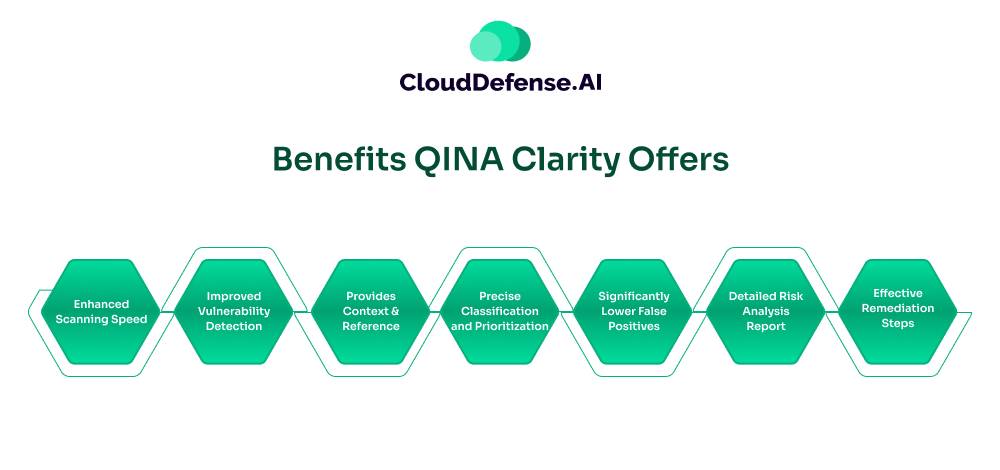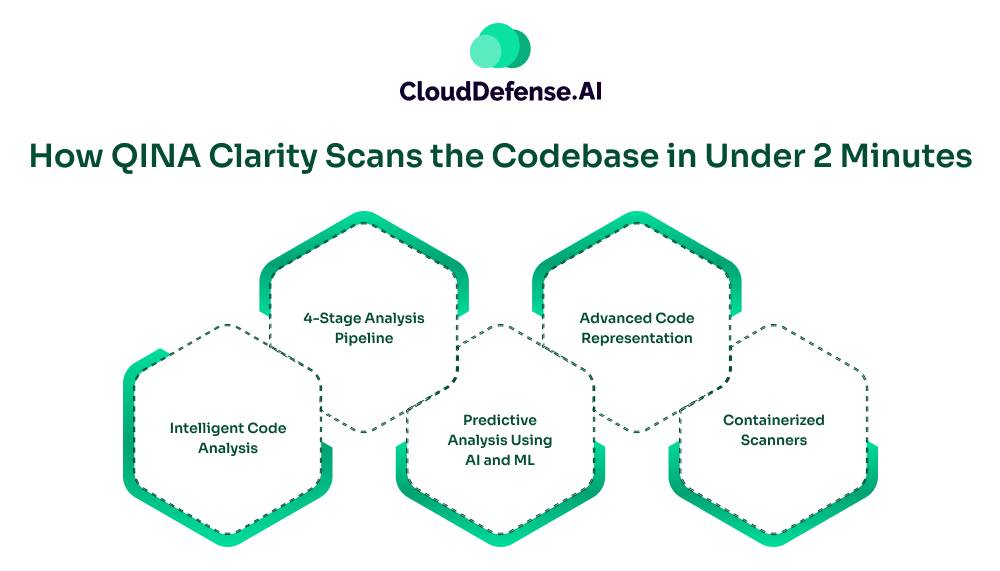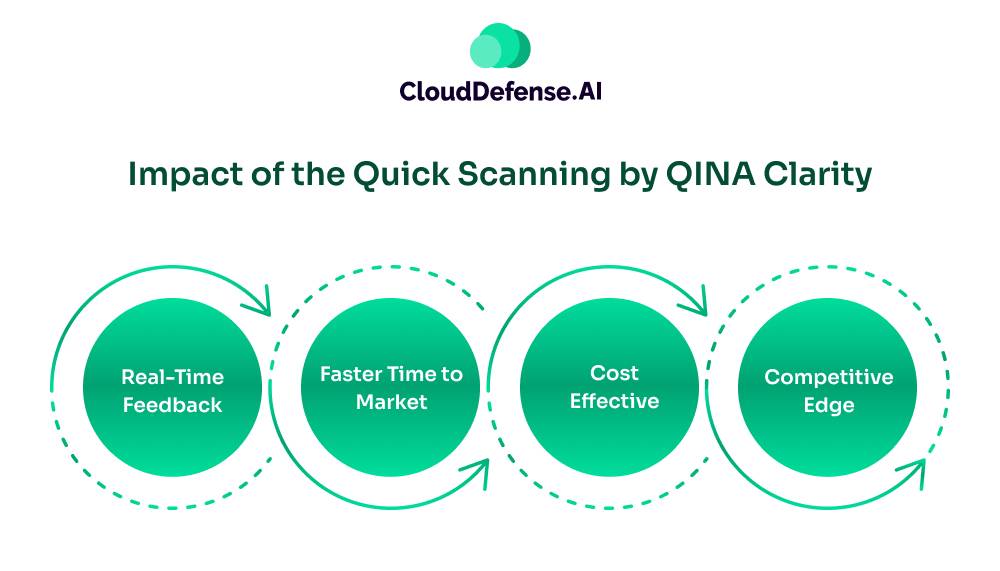In today’s application development process, security and speed are of utmost importance. To maintain a fast development cycle, quick and streamlined CI/CD security scanning plays a vital role. For years, traditional Static Application Security Testing (SAST) was utilized for CI/CD security scanning and identifying vulnerabilities in the codebase.
However, this AppSec tool is creating a bottleneck in the modern development process by taking long hours to scan, especially complex codebase. To help organizations overcome this obstacle CloudDefense.AI has come with a next-gen AI SAST, QINA Clarity.
It is an AI-powered SAST that integrates with the CI/CD pipeline and delivers application code scans in two just minutes. What was once an impossible task, QINA Clarity has made possible and helped organizations cope with high-speed CI/CD pipelines. In this article, we will take a deep dive into how QINA Clarity performs CI/CD security scanning in under 2 minutes and provides developers with real threat information.
Benefits QINA Clarity Offers

QINA Clarity is a powerful SAST tool that not only secures CI/CD workflow but offers many more benefits. Here are the benefits developers will get by integrating this AI SAST in the pipeline of CI/CD workflow:
- Enhanced Scanning Speed: What makes QINA Clarity stand out is the super fast scanning. It holds the ability to perform scans in under 2 minutes and identify all the vulnerabilities in the codebase. This helps in the better adoption of the “shift left” approach by identifying vulnerabilities and mitigating them in real-time.
- Improved Vulnerability Detection: This AI-backed SAST tool is always learning from libraries, previous scans, and the latest vulnerabilities list. As a result, it is able to detect nuance and complex vulnerability during CI/CD security scanning.
- Provides Context & Reference: QINA Clarity is not only about super fast code scanning but it is also about understanding the context behind a code. It provides a complete context and helps developers to understand it. Importantly, this tool provides an overview of the vulnerability along with reference tags like OWASP, SANS, and relevant technologies.
- Precise Classification and Prioritization: A major benefit of this tool is that it cuts through all the noise of security scans using its 4-stage pipeline. It provides actionable reports by assessing the severity and potential impact of the identified vulnerabilities. It utilizes intelligent prioritization during final triage and helps developers focus on real threats that need immediate remediation.
- Significantly Lower False Positives: It is able to reduce false positives by a large margin. It understands the code context and vulnerability impact using a 4-stage pipeline. As a result, it highlights which security findings are false positives and
- Detailed Risk Analysis Report: Unlike other AI SAST tools, this solution benefits users with detailed risk analysis reports. It creates a report explaining the business impact and exploitability of the vulnerability. The report is simple and easy to understand, without any complex security vernaculars.
- Effective Remediation Steps: This security solution goes beyond the traditional capabilities of the SAST solution. It provides developers with actionable remediation steps for eliminating the vulnerability from the codebase. It provides remediation steps in real time to developers and allows them to fix the security issue immediately.
How QINA Clarity Scans the Codebase in Under 2 Minutes

QINA Clarity is one of a kind AI SAST that integrates seamlessly with the CI/CD pipeline and provides code analysis within 2 minutes. However, the secret to high-velocity scanning isn’t only limited to its process but also the combination of technologies and AI-driven strategies it utilizes. These components are:
- Intelligent Code Analysis: QINA Clarity doesn’t scan the entire codebase when a change is made. This powerful AI SAST performs an intelligent scan when a developer commits a new code or modifies the existing one. It quickly identifies and analyses new or modified code along with its dependencies, enhancing the CI/CD security scanning process. It understands the code structure and maps the impact of the changes.
- 4-Stage Analysis Pipeline: This tool puts all the CI/CD security scanning findings through an advanced 4-stage pipeline. Here the AI SAST extracts the context from all security findings, takes them through LLM analysis, and classifies them quickly. As a result, it accurately highlights all the must-fix vulnerabilities while leaving out the false positives. LLM plays a vital role in understanding the context and categorizing the real threat from false positives.
- Predictive Analysis Using AI and ML: QINA Clarity leverages artificial intelligence and machine learning models that are trained on billions of lines of code and evolving vulnerability patterns. Thus, it is able to quickly detect any vulnerable pattern and the impact it will have on the application. During the CI/CD security scanning, this tool can prioritize high-risk code paths and put them quickly through a 4-stage pipeline for LLM analysis.
- Advanced Code Representation: Modern AI SAST tools like this don’t parse the source codes line by line. Instead, it converts into a modern structure known as Code Property Graph or CPG. It takes the control flow, data flow, and syntax and puts them in a graph to enable AI to track how data moves through the application. It helps quickly identify how the code moves from user input to database query. The AI SAST from CloudDefense.AI shows the interactive code flow to developers for better understanding.
- Containerized Scanners: AI SAST tools like QINA Clarity are also designed to integrate with cloud-native architecture. In such an environment, it utilized containerized scanners that scan the codebase in split seconds. The analysis process is highly optimized and often utilizes caching to identify vulnerabilities and secure CI/CD workflows.
Overview of the QINA Clarity Quick Scanning in CI/CD Pipeline
QINA Clarity combines all the technologies and strategies to convert the entire CI/CD security scanning into a quick workflow. Here is a brief overview of how the AI SAST completes the scanning in under 2 minutes:
- Code-Commmit Trigger: While working on an application development environment, a developer commits a code. When a code commit or pull request is created, it automatically initiates the QINA Clarity scanning process.
- Quick Scanning: This AI SAST leveraging all the technologies and features quickly scans the codebase. It creates a CPG to understand the code flow and comes with all the security findings.
- 4-Stage Analysis: QINA Clarity leverages a proprietary 4-stage analysis process where it gathers security findings from the scan. A static analysis is performed on the finding for code reachability and they are tagged with a reachability score. The reachable code along with its dependencies goes through a data and control flow analysis. It helps the AI SAST tool to extract the context from the reachables codes which is then inputted for LLM reasoning. The reasoning is done in conjunction with the organization’s business intent to understand the business impact. The result provides all possible security threats along with remediation details. In the final stage, the LLM output is intelligently classified by leveraging reachability context. It provides developers with categorized vulnerability reports with findings that are false positives.
- Real-Time Feedback: The actual threats with prioritized tags are then delivered directly into the developer’s workflow. The security finding details are highlighted along with the prioritisation requirement. All the false positives are also highlighted that developers should avoid.
- Actionable Intelligence and Remediation Suggestion: QINA Clarity not only alerts developers with prioritized security findings but also with actionable intelligence. The developers get a detailed vulnerability report with a proper explanation. A complete context is offered with specialized vulnerability tags and visual code flow. In addition, the tool offers intelligent remediation steps that can be readily implemented.
Impact of the Quick Scanning by QINA Clarity

The impact of the scanning by QINA Clarity within 2 minutes is not all about enhanced scanning speed. It leaves a deep impact on the development lifecycle, invariable on the organization’s business workflow:
- Real-Time Feedback:CloudDefense.AI’s AI SAST integrates the feedback directly into the IDE. The real-time feedback empowers the developers with a complete context and to write code more securely.
- Faster Time to Market: This tool automates the security checks at the early stage of the CI/CD pipeline and provides remediation guidance in real-time. As a result, developers can develop and deploy applications quickly without compromising on security.
- Cost Effective: Through quick CI/CD security scanning, this tool helps organizations identify vulnerabilities in the beginning. It not only helps in curbing the risk of security breaches but also remediation costs at the deployed stage. Thus helping to save a lot of money.
- Competitive Edge: Organizations integrating QINA Clarity in their development workflow get an edge over their competitors. They are able to deliver more reliable and secure applications in the market than their competitors and that too in a streamlined manner.
Final Thought
QINA Clarity is transforming how developers address vulnerabilities in their codebase by completing the scan in under 2 minutes. It is not only empowering the developers to remediate the issue in real-time while writing code but also maintaining a quick dev cycle. It integrates seamlessly for a thorough yet quick CI/CD security scanning and helps in providing a secure application.
This tool is still in its early days but has already made a huge impact on the industry. It is helping organizations to cope with the modern high-velocity development cycle while increasing ROI. Organizations looking to secure the development workflow must consider this tool as it can quickly scan the codebase and save them from hefty remediation costs.







